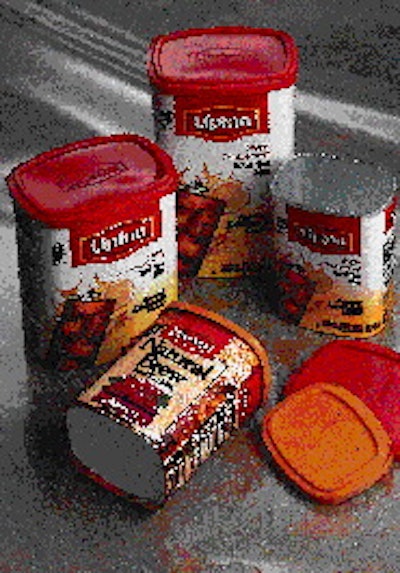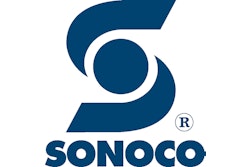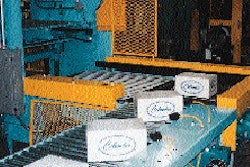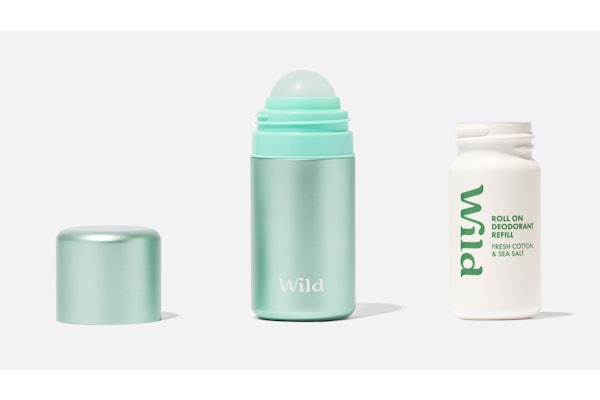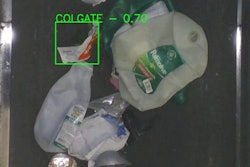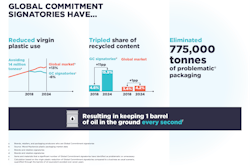The explosive growth in ready-to-drink iced teas certainly grabbed the attention of the venerable Thomas J. Lipton Co., the overall tea category leader in the U.S. To revitalize the popularity of Lipton's tea bags and powdered tea mixes, the Englewood, NJ-based company is relaunching its products in new packaging. And leading the way is Natural Brew, a new five-flavor iced tea mix brand with which the company hopes to compete with ready-to-drink (RTD) products.
Along with a reported $52 million advertising and promotion expenditure, Lipton is investing heavily in new packaging:
* Its new Natural Brew products began rolling out in March in a new rectangular paperboard canister with gravure-printed label. The container, supplied by Sonoco Products (Hartsville, SC), is the first application of new container-making technology (see page 62).
* Lipton's other sugar-sweetened tea mixes will follow Natural Brew to market in five sizes of that same container. New graphics, designed by Gerstman+Meyers (New York, NY), will decorate these rectangular containers.
* A complete new packaging line at Lipton's Suffolk, VA, plant went into production in January to package tea mixes in the nonround containers. It employs a die-cut-and-seal membrane sealer from Osgood (Oldsmar, FL), and a high-speed case packer from Brenton Eng. (Alexandria, MN), along with a new design for the measuring scoop and a new rotary scoop inserter.
* Other non-sugar powdered tea mixes have already gone to market in three new glass jars and new caps. Previously, these products were packed in 12 different glass jar specifications with some nine different cap specifications (see sidebar, opposite page).
* For products like tea bags, new graphics from Gerstman+Meyers will be introduced, even where packaging structures will remain unchanged. A new Lipton brandmark is a focal point to the new graphics (see page 32).
Getting out of round
Probably the biggest change in Lipton's relaunch is the new nonround paperboard container from Sonoco that's used for its sugared tea mixes (also see page 62). Planning for the restaging, Lipton posed two major questions, says Bruce Belowich, Lipton's director of packaging development: "What can we do to innovate in packaging?" and "What can we bring to the market in formulation and branding?" The first products on the shelf in the new 32-oz container are the five flavors of the new Natural Brew line. "Both questions were answered simultaneously," says Belowich. "We weren't going to introduce the new brand in old packaging."
The new rectangular container incorporates a gravure-printed paper label, two plies of 15-pt recycled paperboard, an unspecified thickness of aluminum foil and DuPont's (Wilmington, DE) Surlyn® as the sealant layer.
Lipton's Natural Brew is the first product to use this container. It will be followed by the company's existing varieties of sugared tea mixes, all with new label graphics.
"Retailers gave a very positive reaction to Natural Brew," Belowich reports. "They're enthused because the new packaging will give them a better utilization of their retail shelves. With round canisters, you lose a lot of shelf face-out, and you don't always get the front panel facing out."
Partnering for ECR
Belowich points out that, compared to the previous round canister, the appearance of the label is much improved with the new process. In part, that's because the label is adhesively applied to the container in forming for better registration, rather than being applied later in Lipton's own packaging line.
The potential downside to this is more attention to inventory control-in this case by Sonoco. "For this project, we're single-sourcing all the packaging components through Sonoco," adds Wayne Larkin, Lipton's manager of packaging development. "We simply write one order and Sonoco delivers containers, membrane rollsock and snap caps.
"We don't inventory finished cans. Rather Sonoco inventories finished rollstock. Our order leadtime is about one week. They produce the containers in Hartsville and ship them to our plant via their Suffolk plant." Eventually, Lipton expects Sonoco will shift production of the nonround container to its Suffolk plant.
This just-in-time service enables Lipton to closely respond to sales trends. "Sonoco is well plugged into our production plans," Belowich says, "so we don't have to keep much of an inventory. This type of service really helps us to participate in ECR programs with our customers." ECR is Efficient Consumer Response, a supply chain control program that moves production ever closer to the time of sale.
Debugging a new line
Throughout the package development process, comparability was the goal demanded by Lipton. This meant the new container had to offer shelf life at least as good as the round canister before. The package's mechanical properties, like compression strength, had to be equivalent-and Lipton sought no sacrifice in output from its new packaging line at Suffolk. This is the goal; Lipton admits it's still moving up the learning curve after just a couple months of production.
"Our goal was a packaging line that would at least match-if not exceed-our capabilities before," says Larkin. He declines to identify speeds since it would reveal Lipton's capacity. All of Lipton's powdered tea products are produced on two side-by-side lines at Suffolk. Larkin worked closely with another Lipton engineer, Ken Barden, in selecting the machinery for the new line. It reflects a combination of conventional machines with some unusual ones.
Filling of the new containers is done on a rotary machine from Nalbach Eng. (Countryside, IL) that doesn't look much different from the machine it replaces. Aside from looking newer, Larkin says the filler uses more stainless steel to make clean up easier and it has a number of new quick-disconnect features that help make changeover faster. The containers are subjected to vibration to settle the product.
Scoop inserting
One major change is scoop insertion, even though Larkin claims the technology isn't particularly spectacular. In the past, the round containers were supplied with membrane and snap cap in place. Filling was done from the bottom, with the steel bottom seamed on later. This meant the scoop could be inserted before the product so that it would be at the top when the consumer opened the package. With the new container being filled from the top, the scoop is added last, with the membrane and cap applied in Lipton's line.
"Now we insert the scoop into a filled container. I redesigned the scoop itself, so the handle is at the bottom, not at the top like before," Larkin says. This makes it easier to push the scoop into the powdered product. On the new machine, each scoop is picked up mechanically and aligns itself with a container moving around a rotary base, much like a rotary capper. "The rotary design gives us the time to push the scoop into the product slowly to minimize product dusting."
With the scoop in place, the containers are conveyed into a multilane membrane sealer and overcapper supplied by Osgood. The foil/Surlyn membrane is cut from rollstock with a pull tab at one corner, and heat-sealed to the top edges of the rectangular container. Next, the overcap is precisely placed and tamped down before discharge from this machine.
The injection-molded high-density polyethylene overcap, says Larkin, was a design story in itself. "When you get away from a round shape in a soft resin, you lose the inherent hoop strength. The rectangular shape created a lot of bowing and flexing that could cause the cap to pop off along its long axis.
"We went through about six designs before we shifted from low-density to high-density polyethylene for stiffness and found the right undercut to stay in place." Molded by Packaging Resources (New Vienna, OH) in colors to match package graphics, the caps are supplied via Sonoco.
More efficient cases
Once capped, the containers are conveyed into the case packer from Brenton. It packs them in a 3x4 configuration into corrugated cases that are somewhat smaller than the cases previously used for the round containers.
"Other than just a resizing, we didn't have to add any strength to our corrugated," Larkin says. "That was one of our goals: matching the case compression standards of our previous pack, and we've achieved that." Cases of nonround canisters also fit Lipton's pallets better.
"The new cases can be stacked and maneuvered better on pallets than the cases for the round containers," Larkin says. "The old cases used to overhang the edge of the pallets by two inches. By eliminating the overhang, we get better stacking and less forklift damage."
Just as Lipton performed all the standard case handling tests for drop, vibration and edge crush, it also shipped full pallet loads across the country. Similarly, storage tests on individual containers have been underway for over a year. Accelerated tests indicate a shelf life of up to two years, essentially the same period it had with the previous rounds.
Efficiency is goal
Aside from marketing and consumer-convenience advantages, the packaging lines for the paperboard and the glass containers promise to be more efficient in the future. This is particularly true for glass packaging where changeovers are being minimized. But even as simple a change as consolidating cap colors should enhance the productivity of the paperboard line. So will the elimination of labeling.
"We had a dollar figure in mind in terms of increased efficiencies in our lines," reports Larkin. "Obviously, there is a major gain in efficiency in our glass line, and we expect to eventually see improvements in our paperboard packaging, too.
"That's only part of the story. Thanks to our partnering with Sonoco, we see more efficiencies in purchasing, warehousing and in our glass container costs."
Trade reaction to the new packaging has been very strong, reports Belowich. "Natural Brew has been accepted very broadly. With this brand, we're targeting the users of ready-to-drink iced teas," Belowich says.
If the ready-to-drink products have brought younger users into the tea market, as Belowich contends, Lipton believes it's providing the innovation to further grow the market, with the container packaging breakthrough and also with a new line like Natural Brew.
